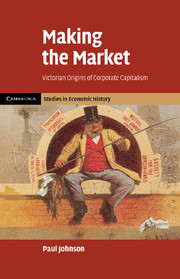7 - Shareholders, directors and promoters
Published online by Cambridge University Press: 06 July 2010
Summary
The mid-Victorian market was characterised by political economists as a largely neutral, natural, self-regulating mechanism in which competitive pressures between a multiplicity of buyers and sellers produced efficient outcomes. In the seventy-five years between the publication of Adam Smith's Wealth of Nations and the Great Exhibition of 1851, Britain had shed almost all the legacy of mercantilist economic interventionism, and had simultaneously become the ‘workshop of the world’. Competitive exchange was widely believed to be the engine of economic prosperity and national prowess, and for some, at least, it also formed the basis of a modern social morality. The shift in social and economic relationships from status to contract identified by Henry Maine was believed to have replaced semi-feudal structures with an opportunity for everyone to define their economic and social worth through free competition in the market. An Economist editorial in 1856 on ‘The Higgling of the Market’ concisely encapsulated this position: ‘Mutual higgling, then, in perfect freedom seems the proper means of determining the rights and duties of all.’
The capacity of economically aware readers of The Economist to higgle in perfect freedom was not shared by the majority of the population. As we have seen in previous chapters, the credit and labour markets were structured by law and custom in ways which significantly constrained the capacity of workers to higgle in the same manner as their more affluent peers.
- Type
- Chapter
- Information
- Making the MarketVictorian Origins of Corporate Capitalism, pp. 197 - 225Publisher: Cambridge University PressPrint publication year: 2010



